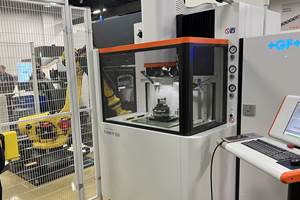New 2.5 kW Laser Gets Great Gas Mileage
Designated the model DC 025, this slab laser requires only a small ten-liter bottle of pre-mixed gas to operate for 6,000 hours, or about a year.
Share





If lasers were cars, this new diffusion-cooled CO2 model from Rofin-Sinar (Plymouth, Michigan) would be among the gas mileage champs. Designated the model DC 025, this slab laser requires only a small ten-liter bottle of pre-mixed gas to operate for 6,000 hours, or about a year. The gas tank resides inside the laser unit, therefore, no external gas supply is required.
Traditionally, the gas used in a laser was circulated through the resonator by roots blowers or other mechanical methods. In this new design the need to continuously replenish the gas is eliminated. Instead, it is diffusion cooled by water which circulates in a jacket that surrounds the electrode plates.
This laser consumes less gas because an exchange is required less than once a day. When required, the exchange is accomplished by a vacuum pump.
There are two primary sources of heat in an industrial laser. The electrodes, which carry current used to excite a gas, and the excited gas itself. In most RF (radio frequency) designs, like the DC 025, the gas is excited indirectly by electrodes located outside the resonator chamber.
In the diffusion design, these electrodes are located in parallel slabs (rectangles) that form the top and bottom for the resonator chamber. The front and rear of the chamber are mirrors.
One mirror is 100 percent reflective, the other (output) is partially reflective. The gas is excited by power applied through the electrodes. Eventually this gas emits photons which oscillate between the mirrors. As the reaction continues some of the photons pass through the partially reflective mirror and become a laser beam.
Heat generated by the excitation of the gas is diffused into top and bottom resonator electrodes, which are essentially water jackets, and it is dissipated by the water circulating through them. Both the electrodes and gas are cooled by the same system. This simplifies the laser unit and significantly reduces pre-mix gas usage.
Elimination of the gas circulation system provides several benefits to the laser user. Without the gas flow components, overall power consumption for the laser unit is reduced. Power is consumed only when the laser is working. Without moving parts such as pumps and turbines, needed to circulate the gas, maintenance is reduced and system reliability increased.
Reduction of components makes the overall laser unit significantly more compact. Dimensions of the laser head are 1700 × 800 × 740 mm. The small size allows the laser head to be integrated into numerous manufacturing systems including flying optics and moving table machine designs where lasers of this power level would traditionally not be practical because of their size and weight.
Reducing the complexity of industrial lasers has been an ongoing goal of manufacturers. In the case of the Rofin DC 025, elimination of complex gas circulation systems and replacing it with the relatively passive diffusion cooling system is a step toward simplification.
Of course the ultimate goal for laser design is to create a dependable and accurate metalworking tool. Diffusion cooling of the gas creates a very stable resonating chamber. The laser beam produced therefore is also stable. Good beam quality is critical for the precision welding and metal-cutting applications for which this unit was designed.
Resonator design of the DC 025 laser contains corrective optics that generate an output beam approaching Gaussian mode. The power distribution (beam quality) of this 2.5 kW laser, at the focus position, has a K-factor better than 0.7.
The DC 025 is the largest of several diffusion cooled models manufactured by Rofin-Sinar. Output power ranges for this slab laser line are from 1.5 to 2.5 kW.
Related Content
EDM, Laser Micromachining and More at GF Medical Demo Center
At GF’s Medical Center of Competence, the company shows off EDM and laser features that could make a large impact on medical manufacturing — and elsewhere.
Read More3 Lessons Job Shops Can Learn From Laser Cutters
This laser-cutting “job shop” designs its processes to make high-mix, low volume work profitable.
Read MoreFlow Waterjet Cutting System Provides Fast Overall Cut Time
IMTS 2024: Flow’s Mach 200c five-axis cutting system features high-speed motors and drives for rapid speed and acceleration and deceleration.
Read MoreMuratec Hybrid Machine Combines Punch Press, Fiber Laser
The MF3048HL combined punch press and fiber laser provides precise cutting, punching, tapping and forming operations on a diverse range of materials.
Read MoreRead Next
Machine Shop MBA
Making Chips and 91ÊÓƵÍøÕ¾ÎÛ are teaming up for a new podcast series called Machine Shop MBA—designed to help manufacturers measure their success against the industry’s best. Through the lens of the Top Shops benchmarking program, the series explores the KPIs that set high-performing shops apart, from machine utilization and first-pass yield to employee engagement and revenue per employee.
Read MoreLast Chance! 2025 Top Shops Benchmarking Survey Still Open Through April 30
Don’t miss out! 91ÊÓƵÍøÕ¾ÎÛ's Top Shops Benchmarking Survey is still open — but not for long. This is your last chance to a receive free, customized benchmarking report that includes actionable feedback across several shopfloor and business metrics.
Read MoreAMRs Are Moving Into Manufacturing: 4 Considerations for Implementation
AMRs can provide a flexible, easy-to-use automation platform so long as manufacturers choose a suitable task and prepare their facilities.
Read More





















